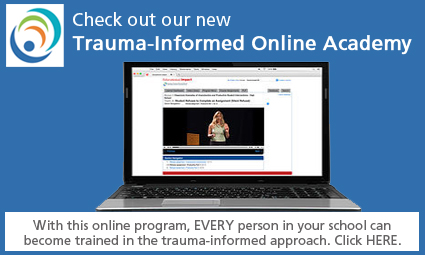

December 12, 2017 Volume 11 Issue 5




Empowering Our Children
With the avalanche of sexual harassment charges making headlines, I have been reflecting on how childhood experiences of trauma impact the unfolding of such experiences when children become adults. Childhood blueprints powerfully impact the way we respond, react, and interpret situations we encounter as adults. The way we think, act, and behave is a direct reflection of our past.
For children impacted by trauma, the blueprints that become part of their being are, unfortunately, very negative. Unchecked and unaddressed childhood trauma puts our children in a vulnerable position as they navigate the "real world" as adults. Blueprints of powerlessness, helplessness, and hopelessness can easily lead to either the abuse of power or complete submission to those in power.
As parents, educators, or mentors in children's lives, we have a powerful responsibility to address these negative blueprints. Here is a list of seven ways to help children change their negative blueprints into positive ones on their developmental journey into adulthood as they heal:
- Foster self-love. Self-confidence, self-worth, self-validation, and self-respect are essential to self-love. Trauma negatively impacts all of these because the messages often sent to the child through the experiences of trauma are: you aren't lovable, you aren't worthy, and you aren't good enough.
Unwinding these internal beliefs begins with the loving adult in the child's life giving the opposite messages to the child: you are lovable, you are worthy, and you are good enough. However, these new messages cannot come just verbally. They have to come through the actions of the adult. The adult has to unconditionally love the child through actions that are free from power and control and free from judgment. No matter the behaviors of the child, the adult has to continue staying connected in a loving relationship. Directives have to be given to teach new behaviors and consequences may need to be imposed but the relationship is never compromised.
A trauma-informed approach gives this to a child. It places the relationship in front of behavior. When children experience this type of unconditional love from the adults in their lives, it opens the door for them to return that type of love back to themselves. As they move into adulthood, they are no longer at risk of entering adult relationships asking other people to validate them. This puts them in a position where they are less vulnerable to other people's actions.
When children have confidence in their own actions, they develop a deep sense of self-respect, giving them the ability and courage to stop anyone who might want to take advantage of them in any way. It also creates someone so secure in themselves, that they do not seek to control others or have a need to abuse their position of power because they are fully in their own personal power.
- Teach emotional expression. Many children impacted by trauma learn one emotion: anger. They are angry at the world, themselves, parents, teachers, and God. Anger is pervasive in their lives. Even for children who shut-down and do not openly express their anger, they are shutting down because the anger is too much to handle. Anger is also a protective emotion. It is easier to feel anger than it is to feel fear, sadness, or shame.
There are five basic feeling words that you can start teaching children or young adults: mad, sad, scared, happy, and grateful. You do not need any special therapeutic books...simply use the books you already have to teach emotions. Use the characters in the stories that children are already familiar with to point out how the characters are feeling and ask emotionally driven questions.
At the Beyond Consequences Institute, we have a new book just published that gives an example of how to do this. The Gingerbread Girl is a story of an empowered, clever, and graceful young lady who [spoiler alert] prevails in the end, as opposed to the classic story of The Gingerbread Boy who gets eaten. At the back of this book, I have written a social/emotional guide to give an example of how any book can be made into a resource for teaching emotional expression. For more information and special new release pricing, click here.
- Give children a voice. Interacting with our children in a way that allows them to have a voice and to be heard sets a standard for them. It tells them that their voice matters. When children learn early in their lives to voice their opinions, concerns, and desires, they are establishing a blueprint that will give them the ability to appropriately speak up later in life to those in authority, rather then allowing fear to hold them back.
Many times during traumatic events, children are told not to tell or to say anything to anyone. Their abusers threatened them with even more severe punishment if they do. Thus, trauma robs children of their voice. Many times, the depth of fear given by the abuser silences them to the point that their bodies lock up and they literally cannot speak, even if they want to.
Regaining the ability to speak is part of a child's healing process. They need to be able to have their voice back to regain their ability to stop future predators. Be sure to open up the space for children to have a voice. This does not mean they always get their way but it does mean their opinions and desires are taken seriously and taken into consideration by the adults in charge of them.
- Change the victim blueprint. Children impacted by trauma experience vulnerability at a very young age. They are hurt very deeply and have become victims to people who were supposed to be the safest people in their lives. They gave their personal power away to someone who was supposed to take responsibility of them. Yet, what they got in return was broken trust, broken relationships, and a broken heart.
Getting children out of a victim blueprint requires someone first taking responsibility for what happened to them. If the adult who created the pain is unable or unwilling to take responsibility, then it has to be an adult close to them. If you are the closest person to this child, you may not have had any part of the traumatic experience, so it is not about you having to take the blame. It is simply about you opening your heart to their pain, "I'm so sorry this happened to you. If I had been there, I would have done anything to make sure this didn’t happen to you."
When adults can take responsibility for children's previous traumatic experiences, it has a powerful impact. It helps them move forward on their own forgiveness journey. Eventually, it also helps them to start to take responsibility for their actions and for what happens in their lives, without blaming others.
- Teach a new story of empowerment. The classical stories of the prince coming to save the princess teach a lesson of disempowerment, as well as a level of helplessness and powerlessness to our girls. It also gives our boys a distorted view of their role in relationships and the helplessness of women. For children impacted by trauma, they have already experienced helplessness so these types of stories only drive home the negative blueprint of disempowerment.
We need to give examples of empowerment and stories of how, when we dig deep within ourselves, we can accomplish anything to which we put our minds. Children learn by modeling so we need to give them stories with characters who model creativity, cleverness, and commitment in order to reach success and happiness through actions of their own (see The Gingerbread Girl for an example of this). Such models of self-determination and self-empowerment will serve them through the challenges they face as adults.
- Teach children problem solving skills. As mentioned in point #4, when children experience trauma, they experience what it means to be a victim. As much as no one wants to be a victim, it can become a familiar pattern, especially for children who experience perpetual trauma. Long-term trauma sets patterns for our children...it is not about what is right or wrong, good or bad, but rather what is familiar.
To change these negative but familiar blueprints, children impacted by trauma need to regain a sense of control over their worlds. Teaching children healthy problem-solving strategies can give them the essential feeling of having options and control over what happens in their lives. It helps them to see how they can make their lives different and how they can improve situations that are not suiting to them. This gives children the skills and the process needed to take action or at least to have confidence that they can find out what is needed to take action, rather than simply giving into a situation and not knowing how to find their way out of it.
- Reconnect children with their gut instincts. Children impacted by trauma sometimes lose touch with their own intuition. They become "shape shifters" to please those abusing them. They take on the likes, dislikes, and personalities of abusing adults in an attempt to fit in and be safe. They abandon themselves and do not know who they are anymore. They lose the ability to listen to their own inner voice.
For children who come out of orphanages, some do not even know when they are hungry, thirsty, or need to go to bathroom. They have lived in such a fearful and regimented environment that they have lost touch with their bodily signals.
The body has intelligence and it is always giving us signals. For example, you might have been walking down a street once and "felt" someone behind you even though you could not see or hear them. These signals from the body are guiding us to safety, happiness, and love. Thus, we need to help children impacted by trauma to get back in touch with their bodies. Teaching mindfulness and bodily awareness helps them to reconnect with their inner voice of guidance and the physical signals of their bodies.
We cannot change the experiences our children have endured but we can help them to change their blueprints for future experiences. Traumatic experiences leave a deep imprint but so do unconditionally loving relationships. Our ability to move children from negative blueprints to positive blueprints can help to make certain that we as a culture never go back to allowing the undercurrent of sexual harassment to be a reality again. Love and empowerment are the key!
Press on,
 Heather T. Forbes, LCSW
Heather T. Forbes, LCSWParent and Author of Beyond Consequences, Logic & Control: Volume 1 & Volume 2,
Dare to Love, and Help for Billy.
| OnDemand | - | 10-Session Online Parenting Course | - | www.OnDemandParenting.com |
| Jan. 3 |
- | Francis Howell School District | - | St. Louis, MO (Private Training) |
| Apr. 3 |
- | St. Charles School District | - | St. Charles, MO (Private Training) |
| Apr. 6 |
- | FCCRB Spring Institute | - | Union, MO (Private Training) |
| May 17 | - | Tanager Place Conference | - | Cedar Rapids, IA |
| Jun. 18-20 |
- | The Trauma-Informed School Conference - Spring | - | St. Charles, MO - SAVE THE DATE |
| Sept.. 6-7 |
- | Kansas MTSS Symposium | - | Wichita, KS - (Private Training) |
| Sept. 30 to Oct. 2 | - | The Trauma-Informed School Conference - Fall | - | Sacramento, CA - SAVE THE DATE |
